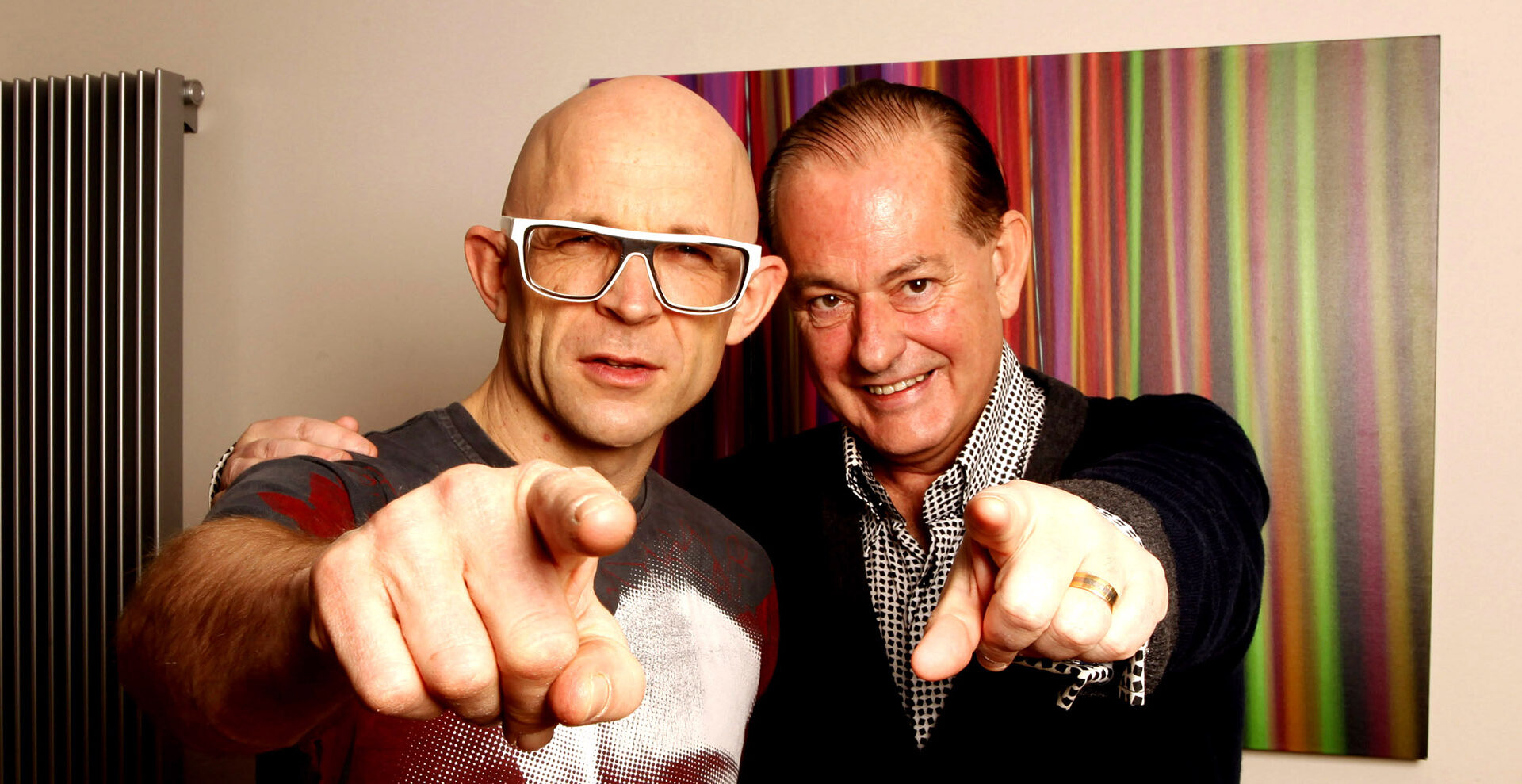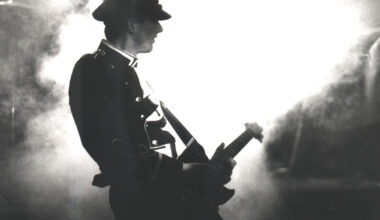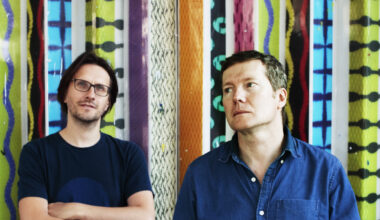Heaven 17 man and former Human Leaguer Martyn Ware meets Gadget Show presenter and soon-to-be pop star Jason Bradbury for a day of music, stories and top quality geekery
In a studio packed with synths and drum machines and other assorted analogue jiggery-pokery, two men are hunched over a Roland Jupiter 4. The one in the cardigan and the pointy purple shoes – shoes so pointy they could pick winkles at 100 paces – is pressing keys and pushing buttons and twisting knobs and wringing all kinds of mad noises from the vintage machine. The other man, the one with the fancy hat and the white framed spectacles, is watching intently, occasionally adding pokes and flicks of his own into the mix. Suddenly, seemingly from nowhere, there’s a burst of sweet, bright, twinkling arpeggio.
“Whoooah!!” shouts Fancy Hat, stepping back sharply. He turns to me and grins. “Listen to that,” he says, nudging me in the ribs, his voice pitching up in his excitement. “Listen to it! Oh man, that’s unbelievable!”
“The interesting thing about the Jupiter 4 is that the filters and the envelope are very precise,” says Pointy Shoes. “So you can do really good short sounds and it’s great for arpeggiation.”
“Straight away, he’s got an amazing sound out of it,” says Fancy Hat. “I knew he would. Listen to that, it’s gorgeous. Gorgeous!”
Pointy Shoes is gunning the machine hard now. For a moment, I expect to see silver stars and golden butterflies and a little neon rainbow shooting from the instrument. It really does seem like there’s some sort of sonic magic going on.
“So you can do all this arpeggiation and then blend it into a cloud of sound, which was a revolutionary idea,” continues Pointy Shoes. “I just love that. It’s like Debussy, isn’t it? You get that cloud of tonality and then you can start picking out all the harmonics with the filters. There was a song on the second Human League album called ‘WXJL Tonight’ and I wrote that two weeks after getting one of these. I was just so thrilled with the sounds I could get from it. It totally inspired me.”
“That was brilliant,” declares Fancy Hat, as the cascading notes float off into the air. “I’ve had the Jupiter 4 for a while and I’ve never got anything that sounds like that out of it before.”
The man with the pointy shoes is Martyn Ware, the Human League, Heaven 17 and BEF man. Not content with being an electronic music legend, Martyn is also a pioneer of 3D sound, one of the deepest thinkers in the music business and an all-round lovely bloke to boot. The cat in the hat is Jason Bradbury, the presenter of the hugely popular UK TV technology programme ‘The Gadget Show’. Away from the cameras, Jason is a big fan of electronic music. He’s a sometime electro DJ and he plays in a band called System 100. He’s also a collector of vintage synths – and Martyn has popped round to Jason’s house to give his gear the once over.
Jason is exactly like he is on the telly. Charming, engaging, boyishly enthusiastic about everything. I arrive at his place to find him sitting on the kitchen floor, fixing a knee-high robot. “There’s something up with his leg,” he says, holding the metal appendage aloft. Behind him, there’s a large multi-coloured painting on the wall, which turns out to be an audio speaker. Through the window, I can see a pristine white Sinclair C5 parked next to Jason’s studio at the bottom of his garden. I suppose this is all to be expected at a gadget guru’s house. Martyn can’t resist jumping into the C5 as soon as he gets a chance.
Jason’s System 100 bandmates Gerwyn Williams and Tim West are here too. They have several conversations with Martyn about music theory throughout the day, including a lengthy discussion about circular fifths. Tim’s Twitter blurb – “There’s this really simple basis to what music is and how it works. It’s connected with the way the rationals are embedded in the ‘reals’ (which aren’t)” – will give you some idea where he’s coming from. Or maybe not. The line-up of System 100 is completed by singer Molly McQueen. Martyn Ware’s jaw almost hits the floor when she turns up.
“What the bloody hell are you doing here?!” he says as she walks through the door.
“Thought you’d be surprised to see me,” laughs Molly, throwing her arms around Martyn’s neck.
“You’re Jason’s singer? Well, I had no idea. Aww, it’s good to see you. How’s your dad?”
Molly’s dad, it turns out, is Midge Ure. Not that she’s here because of a heavyweight family connection. She has a glowing reputation of her own. She was the lead singer with The Faders, the all-girl pop rockers who had a UK hit single with ‘No Sleep Tonight’ a few years ago.
“Molly has a terrific voice and is a massive asset to the band,” says Jason. “We’re still just finding out feet, just starting to get some tunes together, but I’m so excited by this project. I’ve always loved my music. As a kid, I was a breaker, a bodypopper. I love electro, I love funky stuff. Mantronix, Bambaataa, Grandmaster Flash, singers like Joyce Sims and Shannon. I’m really into my DJing and I’ve always made music, I did some basic stuff with an Atari in the 90s, but System 100 is obviously several steps on from that. I think we’re sounding pretty good and I’m not sure I ever expected that.”

Back in Jason’s studio, Martyn has finally been enticed away from the Jupiter 4. He’s spent quite a long time playing with a Sequential Circuits Pro-One (“VInce Clarke loves this,” he says) and a little Roland SH-101, which Jason says was the first synth he mastered (“The sliders helped me to learn about envelopes, because I could see the shape the sliders made and understand what the sound was going to do”). Now Martyn is on the Jupiter 8 and he’s making some dark and nasty wibbly-wobbly sounds. Before long, he’s in ‘Being Boiled’ territory.
“Everything we ever did in The Human League, we had to create all the instruments from scratch,” says Martyn. “All the percussion, for instance. There was no such thing as a preset bass drum or snare or whatever. Everything had to be created from scratch. It was like a weird educational experiment. I didn’t have any musical training – nothing at all – so I learnt everything through experience and I learnt about timbre before I learnt about composition. But the plus side of that was I didn’t know what the boundaries were. Our first synth was a System 100 and one simple phrase in the manual changed my life. It said, ‘There are no illegal connections’. And since this stuff won’t make a noise unless you connect things up, you have to go there and experiment. It’s part of the DNA of how you make the sounds. So that’s what I did. I connected up anything and everything I could.”
“I can’t believe you actually read a manual,” chuckles Molly. “That’s not normal for a man, is it?”
“I used to love the old manuals,” says Martyn. “They weren’t written for geeks, they were written in layman’s terms. You’ve got to remember who they aiming at with those early synths. They weren’t aiming at professional musicians, they were trying to take consumers away from the home organ market.”
Martyn turns back to Jupiter 8 and plays a quick refrain of ‘Don’t You Want Me’. He grins and mutters something about not wanting to give any PRS money “to him”. I mention that I recently saw a quote from Phil Oakey saying he’d like to work with Martyn again.
“Yeah, well, we’re mates again now,” he replies. “Facebook buddies and everything. I mean, even after the split, The Human League and Heaven 17 carried on working in the same studio. They were working on ‘Dare’ and Heaven 17 were working on ‘Penthouse And Pavement’. It was like an arms race to see who could get their album out first.”
He prods around on the Jupiter 8 some more, concentrating on the low end.
“I got one of these when they came out, must have been about 1981, and I used it a lot on ‘The Luxury Gap’. I wasn’t in love with this machine, though. We ended up using hardware sequencers to trigger a lot of the sounds. I programmed it all very mathematically.”
“I love ‘The Luxury Gap’ so much,” says Jason, rifling through a record box on the floor and pulling out a clearly much-played copy of the album. “For me, the key to Heaven 17 was you blended funk and black soul with synthpop. The sounds were very unusual, very electronic and sometimes orchestral, but there was always real quality and real character in the sounds. ‘Let Me Go’ is on this, which was the first ever TB-303 track, wasn’t it?”
“One of the first, yeah,” answers Martyn. “I had three 303s and they all got nicked from the studio. People used to slip them into their pockets and walk off with them.”
As the morning turns into afternoon, Martyn continues to drift around the room, playing a few things here and there. Jason asks if he can record some of it and, to his delight, Martyn says “go ahead, use whatever you want”. Martyn seems quite taken by the DSI Tempest drum machine, which is the creation of ex-Sequential Circuits engineer Dave Smith, the man who invented MIDI. At one point, his enthusiasm gets the better of him and he almost knocks the TR-808 sitting above the Tempest off its rack.
“Don’t worry about that,’ says Jason.
“Those things are so rugged. You could drop it and it’d be fine. I had it repaired and the guy who fixed it also fixed Orbital’s. He told me Orbital had been using their 808 for live gigs and it was so knackered they had to have it upside down with a fag packet pressing the start/stop button. It was pretty much running the whole live show and they’d it like that for 10 years.”
Later on, after Jason has played Martyn and me a couple of System 100 tracks, we’re standing around drinking coffee and the conversation drifts from Jason’s band to the forthcoming new BEF album to Martyn’s three-dimensional sound work with the Illustrious Company, which he set up with Vince Clarke in 2001. Martyn and Jason buzz off just about eveything the other says. They talk about nanotechnology and holograms and recursion and data sonification and navigating through atoms, about robotic operas and cameras with 170 degree lenses, about floors made of touchscreens at The Pentagon and something called the AlloSpehere at the University of Santa Barbara, which is a 30-metre wide sphere of projections and 3D sound you can walk through. After a while, I start to feel like I’m in the 22nd century. Which, apparently, I might actually get to see.
“Have you read Ray Kurtzweil’s ‘The Singularity Is Near’?” asks Jason. “It’s about the merging of biology and silicon. Man machines. It’s going to happen and it’s really not far off. Here’s something to think about – the world’s first 1,000-year-old man is currently aged 60.”
Martyn blows out his cheeks at the news that, as Heaven 17 predicted on ‘Penthouse And Pavement’, we really are going to live for a very long time. “I got in just under the bar, then,” he says.
Today, though, the clock is ticking away and Martyn has to leave. But not before he’s spent a bit more time back on the Jupiter 4.
“I can’t keep my hands off it,” he says. “I wish I hadn’t got rid of mine. I’ve got to get one again. Tell you what Jason, if you can find me one of these I’ll do a remix of one of your tracks. Is that a deal?”
“A remix? You’re kidding me.”
“Listen, I’ll do you a remix anyway. Just let me know when you’re ready. So is that a deal?”
“That’s a deal alright, ” says Jason.
A Quick Guide To Martyn Ware
Worked in computers before becoming a founder member of The Human League in 1978
Left The Human League to form Heaven 17 in 1980 and formed the British Electronic Foundation production company that same year
Worked as a record producer with the likes of Erasure, Marc Almond, Chaka Khan and Tina Turner, whose career he revitalised with ‘Let’s Stay Together’ in 1983
Recorded two albums with Vince Clarke (as The Clarke Ware Experiment) in 1999 and 2001
Founded the Illustrious Company with Vince Clarke in 2001 to exploit the creative and commercial possibilities of their unique 3D sound technology
His 3D sound clients include the Royal Ballet, the Royal Greenwich Observatory, Tate Britain, the V&A Museum, the Science Museum and Amnesty International
Also visiting professor at the University of London, visiting lecturer at the Harvard Graduate School of Design, and member of the LA-based think tank Matter
Said to have featured on recordings totalling around 60 million sales worldwide during his 35-year career
A Quick Guide To Jason Bradbury
The host of the UK TV technology programme ‘The Gadget Show’ since it launched in 2004
Began his TV career working on a cable TV show called ‘Tellywest’, where he worked alongside Sacha Baron Cohen
Partnered ‘Little Britain’ star David Walliams in a comedy double act during the 1990s
Holds several world records, including the world’s fastest jet-powered luge and the world’s longest jump with a remote-controlled car
Once built a hovercraft using only a car wheel and an industrial sized fan
Author of three children’s books – ‘Dot Robot’, ‘Atomic Swarm’ and ‘Cyber Gold’ – about a young boy who leads a force of crime-fighting robots
Recently set up The Pluto Appeal, a charity raising funds to buy a Da Vinci surgical robot for the neonatal wing of Chelea & Westminster Hospital in London






